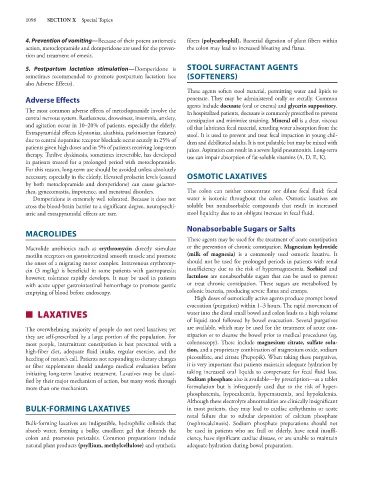Page 1112 - Basic _ Clinical Pharmacology ( PDFDrive )
P. 1112
1098 SECTION X Special Topics
4. Prevention of vomiting—Because of their potent antiemetic fibers (polycarbophil). Bacterial digestion of plant fibers within
action, metoclopramide and domperidone are used for the preven- the colon may lead to increased bloating and flatus.
tion and treatment of emesis.
5. Postpartum lactation stimulation—Domperidone is STOOL SURFACTANT AGENTS
sometimes recommended to promote postpartum lactation (see (SOFTENERS)
also Adverse Effects).
These agents soften stool material, permitting water and lipids to
Adverse Effects penetrate. They may be administered orally or rectally. Common
The most common adverse effects of metoclopramide involve the agents include docusate (oral or enema) and glycerin suppository.
In hospitalized patients, docusate is commonly prescribed to prevent
central nervous system. Restlessness, drowsiness, insomnia, anxiety, constipation and minimize straining. Mineral oil is a clear, viscous
and agitation occur in 10–20% of patients, especially the elderly. oil that lubricates fecal material, retarding water absorption from the
Extrapyramidal effects (dystonias, akathisia, parkinsonian features) stool. It is used to prevent and treat fecal impaction in young chil-
due to central dopamine receptor blockade occur acutely in 25% of dren and debilitated adults. It is not palatable but may be mixed with
patients given high doses and in 5% of patients receiving long-term juices. Aspiration can result in a severe lipid pneumonitis. Long-term
therapy. Tardive dyskinesia, sometimes irreversible, has developed use can impair absorption of fat-soluble vitamins (A, D, E, K).
in patients treated for a prolonged period with metoclopramide.
For this reason, long-term use should be avoided unless absolutely
necessary, especially in the elderly. Elevated prolactin levels (caused OSMOTIC LAXATIVES
by both metoclopramide and domperidone) can cause galactor-
rhea, gynecomastia, impotence, and menstrual disorders. The colon can neither concentrate nor dilute fecal fluid: fecal
Domperidone is extremely well tolerated. Because it does not water is isotonic throughout the colon. Osmotic laxatives are
cross the blood-brain barrier to a significant degree, neuropsychi- soluble but nonabsorbable compounds that result in increased
atric and extrapyramidal effects are rare. stool liquidity due to an obligate increase in fecal fluid.
Nonabsorbable Sugars or Salts
MACROLIDES
These agents may be used for the treatment of acute constipation
Macrolide antibiotics such as erythromycin directly stimulate or the prevention of chronic constipation. Magnesium hydroxide
motilin receptors on gastrointestinal smooth muscle and promote (milk of magnesia) is a commonly used osmotic laxative. It
the onset of a migrating motor complex. Intravenous erythromy- should not be used for prolonged periods in patients with renal
cin (3 mg/kg) is beneficial in some patients with gastroparesis; insufficiency due to the risk of hypermagnesemia. Sorbitol and
however, tolerance rapidly develops. It may be used in patients lactulose are nonabsorbable sugars that can be used to prevent
with acute upper gastrointestinal hemorrhage to promote gastric or treat chronic constipation. These sugars are metabolized by
emptying of blood before endoscopy. colonic bacteria, producing severe flatus and cramps.
High doses of osmotically active agents produce prompt bowel
evacuation (purgation) within 1–3 hours. The rapid movement of
■ LAXATIVES water into the distal small bowel and colon leads to a high volume
of liquid stool followed by bowel evacuation. Several purgatives
The overwhelming majority of people do not need laxatives; yet are available, which may be used for the treatment of acute con-
they are self-prescribed by a large portion of the population. For stipation or to cleanse the bowel prior to medical procedures (eg,
most people, intermittent constipation is best prevented with a colonoscopy). These include magnesium citrate, sulfate solu-
high-fiber diet, adequate fluid intake, regular exercise, and the tion, and a proprietary combination of magnesium oxide, sodium
heeding of nature’s call. Patients not responding to dietary changes picosulfate, and citrate (Prepopik). When taking these purgatives,
or fiber supplements should undergo medical evaluation before it is very important that patients maintain adequate hydration by
initiating long-term laxative treatment. Laxatives may be classi- taking increased oral liquids to compensate for fecal fluid loss.
fied by their major mechanism of action, but many work through Sodium phosphate also is available—by prescription—as a tablet
more than one mechanism. formulation but is infrequently used due to the risk of hyper-
phosphatemia, hypocalcemia, hypernatremia, and hypokalemia.
Although these electrolyte abnormalities are clinically insignificant
BULK-FORMING LAXATIVES in most patients, they may lead to cardiac arrhythmias or acute
renal failure due to tubular deposition of calcium phosphate
Bulk-forming laxatives are indigestible, hydrophilic colloids that (nephrocalcinosis). Sodium phosphate preparations should not
absorb water, forming a bulky, emollient gel that distends the be used in patients who are frail or elderly, have renal insuffi-
colon and promotes peristalsis. Common preparations include ciency, have significant cardiac disease, or are unable to maintain
natural plant products (psyllium, methylcellulose) and synthetic adequate hydration during bowel preparation.

